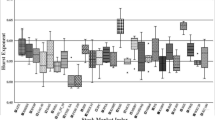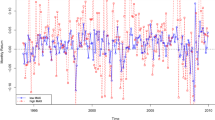Abstract
The present study attempted to analyse the random-walk characteristics of the gold spot price of the London Bullion Market Association (LBMA) by using several linear and nonlinear models. The research collects two decades of daily data from 3rd February 2000 to 2nd October 2020. Econometric tests such as serial correlation test, unit-root tests, multiple variance ratio (MVR), and the BDS test were applied to examine the linear and nonlinear dependence of return series. Further, we employed all the tests from ARCH family to examine the volatility clustering of the gold return series. The results of serial correlation and the unit-root test suggest that the gold return is stationary, therefore does not follow the random-walk benchmark, and hence the gold market is inefficient. EGARCH results indicate that the positive news has a more significant impact on the gold return than the negative news. The findings have important implications for the efficient portfolio investments, and better hedging opportunities for the investors.



Similar content being viewed by others
Notes
The study finds the increase in gold prices of around 42 percentages while there exists a major trench in other financial markets.
[26] documents three versions of informational efficiency such as weak, semi-strong, and strong based on the different types of available information in the market. The financial market is weakly efficient if its current prices quickly reflects all the preceding information that contained in the market trading activity. Under semi-strong category, the asset prices should instantly absorb all the publicly available information set. Strong- form of efficiency enables the prices to absorb both the public and private information set during the trading period.
However, there is a similar study which explored conditional volatility to examine bitcoin market efficiency [27].
The details of the auction of LBMA and the mechanism of the LBMA spot gold price can be obtained from the World Gold Council. The data is also publicly available in the World Gold Council web site. For sake of brevity, we left it on the interest of the readers.
SETS™ is an electronic order book, which trades the UK’s most liquid securities, and therefore raises 86 percentages of transactions in each year and a daily average of 69,000 electronic bargains.
Landmark™ is a market for regional companies which is dedicated to increase the liquidity of the shares traded, and therefore acts as a key source of information about local companies.
For details, refer the cite, https://www.cnbc.com/2016/07/01/brexit-helps-gold-gain-over-25-in-first-half-of-2016.html accessed on 17/12/2020 at 6.50 p.m.
Breusch-Godfrey test examines the auto-correlation of the errors in the regression model. The test is based on the idea of Lagrange Multiplier testing, hence, called as Breusch-Godfrey LM test. It test the null hypothesis of no serial correlation. We have not presented the results of LM statistics here because of the conciseness of space; however, can be obtained with request.
The Augmented Dickey and Fuller (ADF) test examines the null hypothesis that a time series has unit root. The hypothesis will increase the chance of rejection if the magnitude of t-statistics obtained from ADF test will increase with negative sign. The acceptance of null hypothesis indicates the time series has unit root and hence follows random walk, vice-versa. If the null is rejected, then, the series do not follow random walk; therefore, the series is stationary.
The interpretation of Phillips–Perron (PP) test is similar to the Augmented Dickey and Fuller test.
The Kwaiatkowski–Phillips–Schmidt–Shin (KPSS) test examines the null hypothesis that the time series is stationary. The acceptance of the hypothesis will show the time series is stationary and does not follow random walk.
References
Baur DG, McDermott TK (2010) Is gold a safe haven? International evidence. J Bank Financ 1886–1898. https://doi.org/10.1016/j.jbankfin.2009.12.008.
Ciner C, Gurdgiev C, Lucey BM (2013) Hedges and safe havens: an examination of stocks, bonds, gold, oil and exchange rates. Int Rev Financ Anal 29:202–211. https://doi.org/10.1016/j.irfa.2012.12.001
Flavin TJ, Morley CE, Panopoulou E (2014) Identifying safe haven assets for equity investors through an analysis of the stability of shock transmission. J Int Financ Mark Institutions Money 33:137–154. https://doi.org/10.1016/j.intfin.2014.08.001
Tschoegl AE (1980) Efficiency in the gold market-a note. J Bank Financ Financ 4:371–379. https://doi.org/10.1016/0378-4266(80)90015-1
Monroe MA, Cohn RA (1986) The relative efficiency of the gold and treasury bill futures markets. J Futur Mark 6:477–493. https://doi.org/10.1002/fut.3990060311
Baur DG (2013) The autumn effect of gold. Res Int Bus Financ 27:1–11. https://doi.org/10.1016/j.ribaf.2012.05.001
Booth GG, Kaen FR (1979) Gold and silver spot prices and market information efficiency. Financ Rev 21–26. https://doi.org/10.1111/j.1540-6288.1979.tb01743.x
Wang Y, Wei Y, Wu C (2011) Analysis of the efficiency and multifractality of gold markets based on multifractal detrended fluctuation analysis. Phys A Stat Mech its Appl 390:817–827
Smith G (2002) Tests of the random walk hypothesis for London gold prices. Appl Econ Lett 9:671–674. https://doi.org/10.1080/1350485021012458
Pierdzioch C, Risse M, Rohloff S (2014) On the efficiency of the gold market : results of a real-time forecasting approach. Int Rev Financ Anal 32:95–108. https://doi.org/10.1016/j.irfa.2014.01.012
Gallais-Hamonno G, Van HTH, Oosterlinck K (2015) Informational efficiency of the clandestine and official gold markets in Paris. Econ Lett 126:28–30. https://doi.org/10.1016/j.econlet.2014.11.013
Charles A, Darné O, Kim JH (2015) Will precious metals shine ? A market efficiency perspective. Int Rev Financ Anal 41:284–291. https://doi.org/10.1016/j.irfa.2015.01.018
Baur DG, Glover KJ (2015) Speculative trading in the gold market. Int Rev Financ Anal 39:63–71
Bariviera AF, Font-Ferrer A, Sorrosal-Forradellas MT, Rosso OA (2019) An information theory perspective on the informational efficiency of gold price. North Am J Econ Financ 50:101018. https://doi.org/10.1016/j.najef.2019.101018
Bhuyan B, Patra S, Bhuian RK (2020) Market adaptability and evolving predictability of stock returns: an evidence from India. Asia-Pacific Financ Mark 27:605–619. https://doi.org/10.1007/s10690-020-09308-2
Ntim CG, English J, Nwachukwu J, Wang Y (2015) On the efficiency of the global gold markets. Int Rev Financ Anal 41:218–236. https://doi.org/10.1016/j.irfa.2015.03.013
Campbell JY, Lo AW, MacKinlay AC (1997) The econometrics of financial markets, 2nd ed. Princeton University press, princetonNJ
Perron P (1989) The great crash, the oil price shock, and the unit root hypothesis. Econometrica 57:1361. https://doi.org/10.2307/1913712
Zivot E, Andrews DWK (1992) Further evidence on the great crash, the oil-price shock, and the unit-root hypothesis. J Bus Econ Stat 10:251–270. https://doi.org/10.1080/07350015.1992.10509904
Lo AW, Mackinlay AC (1988) Stock market prices do not follow random walks: Evidence from a simple specification test. Rev Financ Stud 1:41–66
Chow KV, Denning KC (1993) A simple multiple variance ratio test. J Econom 58:385–401. https://doi.org/10.1016/0304-4076(93)90051-6
Wright JH (2000) Alternative variance-ratio tests using ranks and signs. J Bus Econ Stat 18:1–9
Blose LE, Gondhalekar V (2013) Weekend gold returns in bull and bear markets. Account Financ 53:609–622. https://doi.org/10.1111/j.1467-629X.2012.00497.x
Tully E, Lucey BM (2007) A power GARCH examination of the gold market. Res Int Bus Financ 21:316–325
Baur DG, Lucey BM (2010) Is gold a hedge or a safe haven? An analysis of stocks, bonds and gold. Financ Rev 45:217–229. https://doi.org/10.1111/j.1540-6288.2010.00244.x
Fama EF (1970) Efficient capital markets: a review of theory and empirical Work. J Finance 25:383–417
Aggarwal D (2019) Do bitcoins follow a random walk model? Res Econ 73:15–22
Acknowledgements
We thank the Indian Institute of Technology Kharagpur, India for providing infrastructure support during the initial stage of this research.
Author information
Authors and Affiliations
Corresponding author
Additional information
Publisher's note
Springer Nature remains neutral with regard to jurisdictional claims in published maps and institutional affiliations.
Appendix
Appendix
AC | PAC | Q-Stat | Prob | |
|---|---|---|---|---|
1 | − 0.000 | − 0.000 | 0.0002 | 0.989 |
2 | 0.004 | 0.004 | 0.0666 | 0.967 |
3 | 0.008 | 0.008 | 0.3826 | 0.944 |
4 | 0.000 | 0.000 | 0.3826 | 0.984 |
5 | − 0.002 | − 0.002 | 0.4135 | 0.995 |
6 | − 0.032 | − 0.033 | 6.1272 | 0.409 |
7 | − 0.012 | − 0.012 | 6.9474 | 0.434 |
8 | − 0.004 | − 0.004 | 7.0516 | 0.531 |
9 | 0.021 | 0.021 | 9.3497 | 0.406 |
10 | − 0.015 | − 0.015 | 10.629 | 0.387 |
11 | − 0.042 | − 0.042 | 20.173 | 0.043 |
12 | − 0.009 | − 0.011 | 20.626 | 0.056 |
13 | 0.031 | 0.031 | 25.796 | 0.018 |
14 | − 0.009 | − 0.008 | 26.233 | 0.024 |
15 | − 0.018 | − 0.018 | 28.083 | 0.021 |
16 | 0.014 | 0.013 | 29.214 | 0.023 |
17 | 0.014 | 0.012 | 30.351 | 0.024 |
18 | − 0.004 | − 0.006 | 30.431 | 0.033 |
19 | − 0.005 | − 0.004 | 30.590 | 0.045 |
20 | 0.021 | 0.023 | 33.026 | 0.034 |
21 | − 0.044 | − 0.046 | 43.358 | 0.003 |
22 | 0.008 | 0.005 | 43.733 | 0.004 |
23 | − 0.030 | − 0.029 | 48.636 | 0.001 |
24 | − 0.032 | − 0.028 | 54.122 | 0.000 |
25 | 0.006 | 0.005 | 54.317 | 0.001 |
26 | − 0.012 | − 0.013 | 55.107 | 0.001 |
27 | − 0.024 | − 0.024 | 58.129 | 0.000 |
28 | 0.005 | 0.007 | 58.286 | 0.001 |
29 | 0.034 | 0.030 | 64.408 | 0.000 |
30 | − 0.027 | − 0.029 | 68.409 | 0.000 |
31 | − 0.013 | − 0.013 | 69.328 | 0.000 |
32 | 0.002 | − 0.000 | 69.350 | 0.000 |
33 | 0.016 | 0.013 | 70.773 | 0.000 |
34 | − 0.014 | − 0.015 | 71.884 | 0.000 |
35 | 0.003 | 0.002 | 71.933 | 0.000 |
36 | − 0.027 | − 0.028 | 75.777 | 0.000 |
Rights and permissions
About this article
Cite this article
Bhuyan, B., Patra, S. & Bhuian, R.K. Do LBMA gold price follow random-walk?. Gold Bull 54, 151–159 (2021). https://doi.org/10.1007/s13404-021-00300-w
Received:
Accepted:
Published:
Issue Date:
DOI: https://doi.org/10.1007/s13404-021-00300-w




